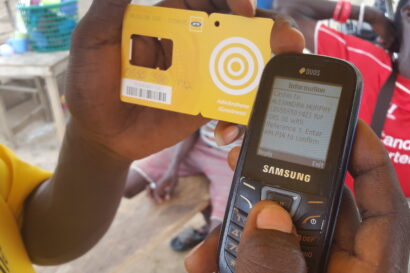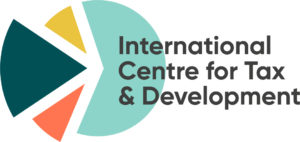Introduced in May 2022, Ghana’s e-levy is a 1.5 per cent tax on the transfer amount of electronic transactions. The objective is to improve tax revenues by tapping into fast-growing digital financial services (DFS). However, many exemptions are applied to the tax design.
A daily and cumulative exemption is fixed at 100 Ghanaian cedis for mobile money transfers, and 20,000 cedis for bank-account transfers. Digital payments to registered businesses are also exempted. The government recently embarked on the second phase of the e-levy, backed by a new, live, digital platform to collect tax revenues.
Two months after the application of the e-levy, key questions include:
- What are its immediate effects?
- How have the different stakeholders reacted?
- Where and what are the gaps and how can they be filled?
- What research is needed?
To begin answering these questions, the DIGITAX team held a webinar in June with a panel discussion on the debates around the e-levy, its implementation, and early behavioural changes. The team also met with several stakeholders in Accra from 4th to 9th July 2022. These stakeholders included the Ghana Chamber of Telecommunications, civil society, mobile-money agents, the informal sector and researchers.
New tax, new behaviour
“When I send money from one account to another, I do not pay tax. But what about the transfers to my wife and children for hospital, education or daily expenses?” – A civil society representative
The webinar and meetings in Ghana revealed several immediate ways the e-levy appears to be affecting different mobile-money stakeholders.
- Once the tax came into force, users panicked, systematically withdrawing cash from their mobile-money accounts.
- The reform has also changed the money-transfer habits of some users who are increasingly reverting to traditional, pre-DFS channels, such as cash. The switch to cash raises concerns of increased crime and aggression, particularly in the informal sector.
- The e-levy has increased the broader cost of living, as a significant number of users continue to rely on mobile money for their daily purchases, and to pay for essential services such as health and education.
- The decline in the use of mobile-money services by consumers and sellers alike has had repercussions on the mobile-money private sector: operators report a decline in transaction values and volumes since the tax came into effect.
- Mobile-money agents have significantly suffered from the decline in the use of mobile-money services. Their commissions proportionately increase with value and volume of transactions they undertake. Additionally, the panic, dissent and uncertainties associated with the tax led to about 4,000 mobile-money agents leaving the industry in the course of April.
On the other hand, there is anecdotal evidence that specified merchant payment exemption is encouraging businesses that previously avoided direct taxes to register with the Ghana Revenue Authority (GRA).
Potentially, this could bring in more revenue as more businesses transit from the informal to the formal sector, thus meeting some of the goals of the levy to broaden the tax base. However, more time, data, and further research are required to clearly understand related effects on revenue and tax compliance.
Webinar panellists also pointed to another new behaviour resulting from the e-levy, but this time from the government. In their view, the government appears to be going to reportedly unprecedented lengths to create a sense of transparency regarding the revenue collected from the e-levy through quarterly reporting by the GRA, and biannual reporting by the Ministry of Finance.
Although some of the behavioural changes are driven by a popular perception that the e-levy is too high, and an equally popular practice that any additional expenses that can be avoided are to be avoided, some of the effects – such as the systematic cash withdrawals – arise from common misunderstanding about the tax.
This is especially true in the period prior to the tax coming into effect. There also seems to be confusion regarding the specified merchant payment exemption, with many people not realising when or why it is applied, or the exemption process for a specified merchant.
Where there is a will, there is a way: navigating around the new e-levy
“Soon all mobile-money users will become mobile-money agents!” – A civil society representative.
Despite the option to switch to cash and abandon electronic transactions, mobile money remains one of the most convenient and safest ways for people to transfer money. And people have found several ‘cushions’ to ‘soften’ the e-levy, or to avoid it altogether.
For example, some people mentioned spreading out transfers over several days so as to be within the 100-cedi maximum daily limit. Another popular option is to take advantage of agent transfer exemptions to avoid user-to-user transfer fees and taxes. Users have been sending money from one agent account to another agent account.
Users have also been requesting agents to send money on their behalf from their (agent’s) account to another user’s wallet, which is illegal: the government has taken decisive steps to curb this (mal)practice. Additionally, some users are considering acquiring agent SIM cards to save time, money, and also avoid haggling with agents on charges for illegal transfers.
For a mobile-money agent, the main goal is to maximise the use of their service, which – for some – includes the illegal agent-to-another-user transfer above. Agents are therefore also engaging in consumer education to raise awareness and to stem the run on mobile money.
What do stakeholders recommend?
To limit the negative effects of the e-levy on the supply and demand of financial services, stakeholders propose several solutions.
- The most common is a reduction in the tax rate, which they find too high. Most stakeholders propose a rate of 0.5 per cent. This rate is perceived as fairer because it is lower than the transfer fee of 0.75 per cent charged by the mobile-money companies that provide the service.
- A tax on the transfer fee charged by mobile-money companies, rather than on the value of the transfer itself.
- Reduce the e-levy rate in inverse proportion as transaction value increases, to encourage and reward large-transaction values. Alternatively, apply a cap on the amount of the tax chargeable.
- An increase in the daily exemption threshold for mobile money, to at least match the bank transfer threshold of 20,000 cedis.
- ‘Ringfencing’ or earmarking the e-levy revenue in the same manner as the Ghana National Health Insurance Scheme. Ghanaians are willing to pay taxes, but they also demand adequate investment of the revenue collected in good-quality public services and greater government accountability.
Incentives are a powerful mechanism to increase tax compliance. The e-levy is no different, and the informal sector was particularly adamant, unequivocal and vocal: government provision of social protection, pension or sanitation systems in exchange for taxes paid would encourage most informal-sector workers to willingly comply and pay due taxes.
What next?
The webinar and different interactions with stakeholders also revealed several areas requiring further research.
- Inferring the impact of the e-levy more comprehensively by considering different stakeholders such as mobile money operators, users, businesses and agents.
- Comparative study between the formal and informal sectors. One of the objectives of the e-levy is to broaden the tax base and painlessly expand the formal sector through a carrot-and-stick approach by exempting payments to registered sellers. · Study the impact of e-levy on the most vulnerable populations. Persons with reduced mobility, women, students and informal workers appear to be more vulnerable to the negative effects of the tax.
- Study the impact of the e-levy beyond mobile-money usage alone. This includes examining crime rates in relation to increased cash-handling as well as perceptions of safety and wellbeing. · Identify the determinants of e-levy acceptance, recognising that economic, political, social or demographic factors can influence perceptions.
- Highlight key aspects of the e-levy for taxpayers – such as how the revenues are used for public services – and measure how information sharing improves perceptions and acceptance of the tax.
- Examine how the relatively smooth e-levy implementation system can be used to provide public services more efficiently and effectively.
- Estimate the possible effects of tax-reform scenarios to guide future decision-making.
What we have reported centres mainly on early stakeholder opinions and recommendations on the new e-levy. In the coming months, the DIGITAX team will be working on some of these cogent and urgent research questions. Watch this space!




